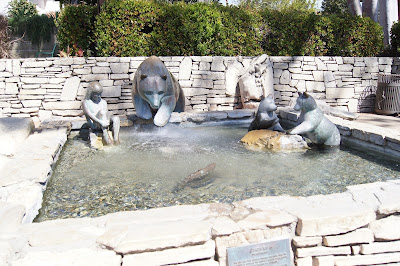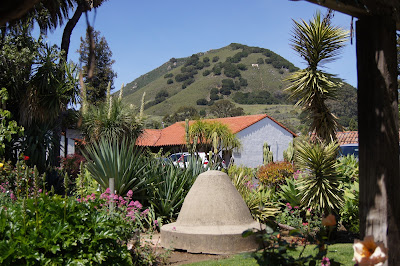Along the Mission Trail
My travels along California's Mission Trail continued with a visit to Mission San Luis Obispo de Tolosa last week. It is the 5th of the 21 missions and was founded in 1772 by Father Junipero Serra. The area around San Luis Obispo was known as The Valley of the Bears and Father Serra sent a hunting expedition here to provide food for starving missionaries and neophytes north of here. The expedition was successful. The hunters brought back thousands of pounds of salted and jerked bear meat. Consequently, Father Serra realized this was a good spot to build a mission so he made the journey north from San Diego and erected a cross here. The construction of the mission was left to Father Jose Cavalier.
Plagued by fires, it was here in 1790 that the missionaries decided to use tile roofs instead of thatched ones. They made the tiles from clay worked by animal hooves and molded the clay around curved wooden forms. All the missions adopted this method for future construction.
Father Serra transferred two bronze bells from the Jesuit Missions in Baja to the missions in Alta California and began the lovely tradition of bell ringing. Unfortunately, these bells were lost over the years, but the San Luis Obispo Mission kept alive the tradition. In 1820, four mission bells were made in Lima, Peru and shipped here. They were cast by the noted bell-maker, Manuel Vargas. The largest bell, Gloria, was placed in the center with Joy and Sorrow on either side. The job of bell ringer was a very prestigious one and took two years of training to properly learn the complicated patterns. Each time during the day when the bells were rung, whether to wake people in the morning, call them to Mass or bid the day farewell, the bells sounded different. It reminds me of the muezzin's calls to prayer in the Middle East.
Today, there are five fourth generation bells that were installed in 2005, and given the names of the patron saints of the first five Alta California Missions: Carlos, Diego, Antonio, Gabriel and Luis. Each has a different pitch ranging from D to F#.
Today, Mission San Luis Obispo de Tolosa is an active parish church within the city. I did not spend a lot of time in the church because there were many people praying and reciting the rosary. I always feel I am invading their privacy when I roam around with camera in hand. However, there is a good museum with many fine exhibits of Chumash arts and crafts. As always, I was most interested in the religious art and vestments. There were five beautiful old vestments on display and I learned a little more about them. The style was called Iberian Fiddleback because of the shape of the cape. The original doors were also on display in the museum. I realized what a labor-intensive job went into the reconstruction of this church in the 1930's. The doors to the entrance of the present church are historically accurate.
During its heyday, the mission supported itself by growing wheat and corn, raising beef and cattle and cultivating grapes. In 1845, when Governor Pio Pico sold the mission for $510, it continued to be used as base of operation for John Fremont during the war with Mexico. Because of its location within a growing city, it was later used as a courthouse and jail.
Although its history is a fascinating one, the location of this mission is what makes it so fun to visit. After touring the beautiful garden in the back, we walked across the street to a restaurant on the San Luis Creek, which meanders through the city. A most pleasant day!












No comments:
Post a Comment